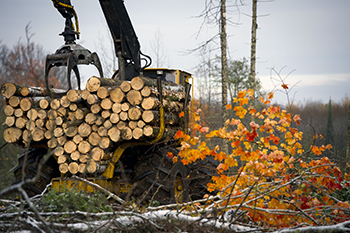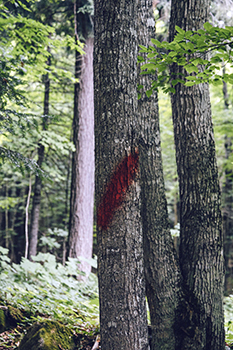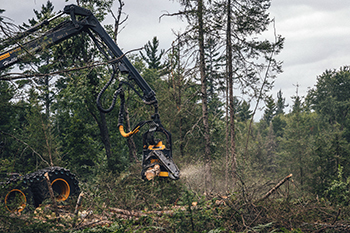What's in a name?
By KATHLEEN LAVEY
Michigan Department of Natural Resources
An important job for foresters in the Michigan Department of Natural Resources is marking the boundaries of timber sales that will take place on state forest land.
They spray-paint trees to do it.
And that’s where one of the timber sales Patrick Mohney was marking a few years back got its unique name.
Mohney’s black lab, Betty, loved to go to the woods with him, back when foresters were allowed to take their dogs to work in the field. But Betty often rushed ahead of Mohney on the trail and got herself into the line of spray paint fire.
The sale’s unique name lives in historic records at the DNR’s Forest Resources Division: "Painted Dog Aspen."
There are many other timber sale names, just as colorful, inventive or just plain wacky.

Some of the current timber sales names include the “Ghostbuster Cut,” “Scrupulous Aspen” and “72 Decibels Mix” in the Traverse City Forest Management Unit and “Pronto Pup Pine” in the Pigeon River Country State Forest.
Folks in Gaylord may have been thinking about the office kitchenette when naming the “Teak Kettle Mix,” the “Coffee Pot Mix” and “Microwave Mixed Pine.”
Creatively naming timber sales is a tradition passed down through the history of logging. A good name helps identify the type of timber to be harvested (The “aspen” part of Painted Dog Aspen, for example) or its relative geographic location.
While some government entities that sell timber have dull naming conventions that include locations and numbers only, DNR foresters get more leeway to follow tradition and exercise their creativity.
“It’s been going on as long as I’ve been around, and well before that,” said Mohney, who now works as the manager of the Forest Resources Division's Gladwin unit. “Some foresters are like, ‘I just threw a name out there.’ But some of them put a lot of thought into it.”
Sometimes a whole office will jump on a theme. A Disney spree in the Shingleton unit led to names like “Little Mermaple,” “Sprucetopia” and “Inside Out Maple.” A pirate theme yielded names such as “High Rollaway Treasures.”
Mohney admits he has themed sale names as well. He recalls one season of marking timber in excessively damp weather.
|

“My boots were always wet, so there was a whole year of sales that I titled after soups,” he said. “Another year it was all music artists that I like.”
In 2020, the DNR prepared 54,222 acres of state forest and national forest timber for sale, a tiny fraction of the state’s forest holdings of just under 4 million acres. Harvested areas provide habitat for many types of wildlife that cannot thrive in deep woods such as grouse and elk.
That same year, the DNR planted 1.8 million trees and works to facilitate natural regeneration in forests that have been harvested. DNR forestry practices are certified as sustainable by two outside organizations.
Foresters have a lot to remember.
Tori Irving, who works out of the DNR’s Shingleton management unit in the Upper Peninsula, said that besides allowing for creativity, naming conventions serve foresters as a memory boost, since planning for timber sales takes place a couple of years in advance.
“As foresters, we touch thousands of acres of land if it’s an inventory or a timber sale,” she said. “The only way that you can remember it is by using something funny that happened or something that is unique to the area. You lost your boot in a swamp or you get your snowmobile buried.”
Remembering the type of forest is important, since foresters serve as the expert to assist loggers who may be interested in bidding on the timber sale and carrying out the logging operation.
“You have all the data and the inventory, that’s all on paper,” Irving said. “The name helps bring a memory so that you can see that forest. You’re the expert they’re asking about it.”
A couple of unwritten rules: Keep the timber sale names clean and inoffensive.
Oh, and one more: “Name them something you can say with a straight face in court,” Irving said.
|

One of Irving’s sale names reflects the somewhat miserable conditions at the time she was working in the forest: “Deer Tick Circus.” She named another one “Hyland Games,” which is both the name of a road in the sale area and a nod to her Scottish ancestry.
Another of Irving’s memorable names was the “Horror Story Hardwoods.” The name wasn’t about the woods themselves.
“The stand was fine,” she said. “It was mixed northern hardwood with some beech. It’s not like it was a nightmare to cut or access.”
But Irving happened to be listening to a frightening audio book while she worked that set her up for some unintended jump scares.
“Every time a branch broke, I freaked right out,” she said.
She named another “The Marsh King Sale” after a book called “The Marsh King’s Daughter” by Karen Dionne, a mystery about a kidnapper who lives – where else? – in the woods and swamps of the Upper Peninsula.
“We’ve had loggers ask, ‘Where did this name come from?’” Irving said. “It’s kind of a cool conversation starter.
Mohney agreed.
“It boosts morale and keeps things interesting,” he said. “We have found it sparks conversation. Producers will bid on a sale and say, “What the heck?’”
|
Check out previous Showcasing the DNR stories in our archive at Michigan.gov/DNRStories. To subscribe to upcoming Showcasing articles, sign up for free email delivery at Michigan.gov/DNR.
Note to editors: Contact: John Pepin, Showcasing the DNR series editor, 906-226-1352. Accompanying photos and a text-only version of this story are available below for download. Caption information follows. Credit Michigan Department of Natural Resources, unless otherwise noted.
Text-only Showcasing Story - Timber sale naming
Marked tree UP: Michigan Department of Natural Resources foresters use spray paint to mark the boundaries of a timber sale. Patrick Mohney, manager of the Forest Resources Division’s Gladwin unit, once named a timber sale “Painted Dog Aspen” after his black lab, Betty, who kept getting in the way of the spray paint. (Photo by Hans Isaacson for the National Association of State Foresters).
Marked timber: Michigan Department of Natural Resources foresters use spray paint to mark the boundaries of a timber sale. Foresters are allowed to use their creativity to name each sale, resulting in some humorous names.
Timber pile: Timber from state forests in Michigan provides wood products Michiganders need. Michigan Department of Natural Resources forest management techniques are certified sustainable by two separate, outside organizations.
Timber sale: Large machines are often used to cut timber to length while still in the forest. Foresters say timber producers will sometimes look at the name of a timber sale and ask how it came about. (Photo by Hans Isaacson for the National Association of Foresters).
|